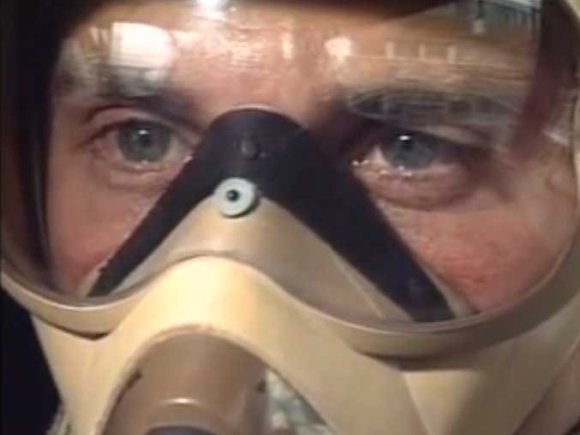
It’s been a week and a half since Malaysia 370 disappeared, and the theory du jour comes from a former pilot.
In a Google+ post, Chris Goodfellow argued that smoke filled the cockpit, maybe from a burning tire on the front landing gear.
The pilots turned the plane toward an airport that could handle the 777, turned off the transponder along with other electronics in an effort to isolate the source of the fire, and were then overcome by smoke, he theorized.
The plane’s autopilot kept the course until it ran out of fuel and crashed hours later.
Goodfellow’s theory is appealing, we noted, because it fits the facts we have on MH370. It impressed The Atlantic’s James Fallows, himself a pilot: “His explanation makes better sense than anything else I’ve heard so far … It’s one of the few that make me think, Yes, I could see things happening that way.”
Other pilots aren’t convinced, though. In an interview with Business Insider, Michael G. Fortune, a retired pilot who now works as an aviation consultant and expert witness, said pilots preparing to change destination “would have communicated their emergency and intentions to turn around, as well as ask for assistance and direct routing to a suitable airport from the air traffic controllers very quickly.”
Goodfellow also wrote: “in the case of fire the first response [is] to pull all the main busses and restore circuits one by one until you have isolated the bad one.”
Fortune, who flew 777-200ERs like the one involved here, said pilots follow a specific procedure when there’s smoke or fire in the cabin. He didn’t buy into the idea that the transponders would have been turned off in an attempt to deal with the problem. “The checklist I utilized for smoke and fumes in the B-777-200ER does not specifically address the transponder being turned off,” he said.
Steve Abdu, a 777 captain for a major carrier, echoed Fortune’s point that there’s a clear checklist to follow in this kind of situation. And, he pointed out, it’s unlikely smoke would have knocked the pilots unconscious or killed them — because they have oxygen masks.
Each pilot has a quick-donning mask, and putting it on is step one on the fire checklist. It covers the full face, even if the pilot wears glasses, and can be put on in about two seconds. “These masks are quite excellent at protecting a pilot from smoke and fumes,” Fortune said.
The masks are impressive. Pressing clips on the face part inflates the harness; letting go deflates it. You can see how an example works in this Airbus instructional video:


 What pilots think about the crazy new theory that the missing Malaysia jet used another jet to hide
What pilots think about the crazy new theory that the missing Malaysia jet used another jet to hide Japanese airline ANA causes controversy by airing “racist” commercial
Japanese airline ANA causes controversy by airing “racist” commercial Notes from the Evangelion payroll department – How much does Shinji earn?
Notes from the Evangelion payroll department – How much does Shinji earn? Japanese airline pilot fails alcohol breath test one hour before he was scheduled to fly
Japanese airline pilot fails alcohol breath test one hour before he was scheduled to fly Man who refused to wear mask on airplane in Japan gets arrested four months later
Man who refused to wear mask on airplane in Japan gets arrested four months later McDonald’s new Happy Meals offer up cute and practical Sanrio lifestyle goods
McDonald’s new Happy Meals offer up cute and practical Sanrio lifestyle goods All-you-can-drink Starbucks and amazing views part of Tokyo’s new 170 meter-high sky lounge
All-you-can-drink Starbucks and amazing views part of Tokyo’s new 170 meter-high sky lounge Studio Ghibli glasses cases let anime characters keep an eye on your spectacles
Studio Ghibli glasses cases let anime characters keep an eye on your spectacles More foreign tourists than ever before in history visited Japan last month
More foreign tourists than ever before in history visited Japan last month Starbucks reopens at Shibuya Scramble Crossing with new look and design concept
Starbucks reopens at Shibuya Scramble Crossing with new look and design concept Beautiful Sailor Moon manhole cover coasters being given out for free by Tokyo tourist center
Beautiful Sailor Moon manhole cover coasters being given out for free by Tokyo tourist center Mister Donut ready to make hojicha dreams come true in latest collab with Kyoto tea merchant
Mister Donut ready to make hojicha dreams come true in latest collab with Kyoto tea merchant The oldest tunnel in Japan is believed to be haunted, and strange things happen when we go there
The oldest tunnel in Japan is believed to be haunted, and strange things happen when we go there Hamster abandoned at Tokyo ramen restaurant gets new home
Hamster abandoned at Tokyo ramen restaurant gets new home This Nara workshop has been making deer crackers for more than 100 years and offers tours【Photos】
This Nara workshop has been making deer crackers for more than 100 years and offers tours【Photos】 Disney princesses get official manga makeovers for Manga Princess Cafe opening in Tokyo
Disney princesses get official manga makeovers for Manga Princess Cafe opening in Tokyo Beautiful new Final Fantasy T-shirt collection on the way from Uniqlo【Photos】
Beautiful new Final Fantasy T-shirt collection on the way from Uniqlo【Photos】 Is the new Shinkansen Train Desk ticket worth it?
Is the new Shinkansen Train Desk ticket worth it? Foreign English teachers in Japan pick their favorite Japanese-language phrases【Survey】
Foreign English teachers in Japan pick their favorite Japanese-language phrases【Survey】 Japanese convenience store packs a whole bento into an onigiri rice ball
Japanese convenience store packs a whole bento into an onigiri rice ball We try out “Chan Ramen”, an underground type of ramen popular in the ramen community
We try out “Chan Ramen”, an underground type of ramen popular in the ramen community Studio Ghibli releases Kiki’s Delivery Service chocolate cake pouches in Japan
Studio Ghibli releases Kiki’s Delivery Service chocolate cake pouches in Japan Japan’s bone-breaking and record-breaking roller coaster is permanently shutting down
Japan’s bone-breaking and record-breaking roller coaster is permanently shutting down New definition of “Japanese whiskey” goes into effect to prevent fakes from fooling overseas buyers
New definition of “Japanese whiskey” goes into effect to prevent fakes from fooling overseas buyers Our Japanese reporter visits Costco in the U.S., finds super American and very Japanese things
Our Japanese reporter visits Costco in the U.S., finds super American and very Japanese things Studio Ghibli unveils Mother’s Day gift set that captures the love in My Neighbour Totoro
Studio Ghibli unveils Mother’s Day gift set that captures the love in My Neighbour Totoro Foreign passenger shoves conductor on one of the last full runs for Japan’s Thunderbird train
Foreign passenger shoves conductor on one of the last full runs for Japan’s Thunderbird train Domino’s Japan now sells…pizza ears?
Domino’s Japan now sells…pizza ears? New Japanese KitKat flavour stars Sanrio characters, including Hello Kitty
New Japanese KitKat flavour stars Sanrio characters, including Hello Kitty Kyoto creates new for-tourist buses to address overtourism with higher prices, faster rides
Kyoto creates new for-tourist buses to address overtourism with higher prices, faster rides Sales of Japan’s most convenient train ticket/shopping payment cards suspended indefinitely
Sales of Japan’s most convenient train ticket/shopping payment cards suspended indefinitely Sold-out Studio Ghibli desktop humidifiers are back so Totoro can help you through the dry season
Sold-out Studio Ghibli desktop humidifiers are back so Totoro can help you through the dry season Japanese government to make first change to romanization spelling rules since the 1950s
Japanese government to make first change to romanization spelling rules since the 1950s Ghibli founders Toshio Suzuki and Hayao Miyazaki contribute to Japanese whisky Totoro label design
Ghibli founders Toshio Suzuki and Hayao Miyazaki contribute to Japanese whisky Totoro label design Doraemon found buried at sea as scene from 1993 anime becomes real life【Photos】
Doraemon found buried at sea as scene from 1993 anime becomes real life【Photos】 Tokyo’s most famous Starbucks is closed
Tokyo’s most famous Starbucks is closed One Piece characters’ nationalities revealed, but fans have mixed opinions
One Piece characters’ nationalities revealed, but fans have mixed opinions We asked a Uniqlo employee what four things we should buy and their suggestions didn’t disappoint
We asked a Uniqlo employee what four things we should buy and their suggestions didn’t disappoint Princesses, fruits, and blacksmiths: Study reveals the 30 most unusual family names in Japan
Princesses, fruits, and blacksmiths: Study reveals the 30 most unusual family names in Japan Japan-stationed U.S. fighter plane crashes in Okinawa
Japan-stationed U.S. fighter plane crashes in Okinawa Why was Malaysia Airlines flight MH17 flying over Ukraine? NHK explains
Why was Malaysia Airlines flight MH17 flying over Ukraine? NHK explains Flight out of Narita Airport delayed because of a turtle on the runway
Flight out of Narita Airport delayed because of a turtle on the runway Really into Evangelion? Then you’ll want an entry plug huggy pillow and necklace【Photos】
Really into Evangelion? Then you’ll want an entry plug huggy pillow and necklace【Photos】 You can take this 33,000-pound robot for a virtual test drive, watch it dance to J-pop 【Video】
You can take this 33,000-pound robot for a virtual test drive, watch it dance to J-pop 【Video】 Get your hands on the Nanoblock version of Evangelion Unit-01, coming this month
Get your hands on the Nanoblock version of Evangelion Unit-01, coming this month Kyoto Animation studio in arson attack found to have been in compliance with all fire codes
Kyoto Animation studio in arson attack found to have been in compliance with all fire codes Mystery, rumour and speculation after Malaysia Airlines plane disappears mid-flight UPDATED
Mystery, rumour and speculation after Malaysia Airlines plane disappears mid-flight UPDATED Flight that crashed in 1985 spotted landing in Narita Airport 35 years later
Flight that crashed in 1985 spotted landing in Narita Airport 35 years later Japanese airline leaves passenger behind at rural island airport after he refuses to wear mask
Japanese airline leaves passenger behind at rural island airport after he refuses to wear mask Japanese billionaire Yusaku Maezawa is selling his private jet because it’s old, gives a tour
Japanese billionaire Yusaku Maezawa is selling his private jet because it’s old, gives a tour Blue Impulse’s cockpit version video gives us an intimate look inside an aerobatic plane 【Video】
Blue Impulse’s cockpit version video gives us an intimate look inside an aerobatic plane 【Video】 Drone brought down in China by team of square-dancing women wanting cakes
Drone brought down in China by team of square-dancing women wanting cakes Gundam face masks will help you stay safe when you have to be mobile during the pandemic【Photos】
Gundam face masks will help you stay safe when you have to be mobile during the pandemic【Photos】
Leave a Reply